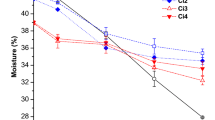Abstract
Bread crumb X-ray patterns were analysed by different methods, the objective being to provide more in-depth knowledge of the relationships among starch crystallinity, amylopectin retrogradation and bread firming. Both crumb-firming and amylopectin retrogradation increased with storage time. However, total mass crystallinity grade and relative crystallinity increased only in the first 24 h. The determination of starch crystallinity requires the separation of the crystalline and amorphous intensities, which is sometimes arbitrary, so it would be useful to improve this methodology. Different methods used to determine total crystallinity grade only show the differences existing between fresh and stored bread. B-type crystal structure—corresponding to the amylopectin retrogradation—increased during bread storage, showing a high correlation with bread-firming and storage time. This fact emphasized the above results and suggested that amylopectin retrogradation is an important component to the elucidation of bread staling.






Similar content being viewed by others
References
Axford DW, Colwell KH, Cornford SJ, Elton GA. (1968) J Sci Food Agric 19:95–101
Bashford LL, Hartung TE (1976) J Food Sci 41:446–447
Willhoft EMA (1973) Baker’s Dig 47:14–20
Schoch TJ, French D (1947) Cereal Chem 24:231–249
Kim SK, D’Appolonia BL (1997) Cereal Chem 54:207–215
Kim SK, D’Appolonia BL (1997) Cereal Chem 54:216–224
Morgan KR, Gerrard JA, Every D, Ross M, Gilpin MJ (1997) Stärke 49:54–59
Inagaki T, Seib P (1992) Cereal Chem 69:321–325
León AE, Durán E, Benedito de Barber C (1997) Z Lebensm Unters Forsch 204:316–320
Armero E, Collar C (1998) J Cereal Sci 28:165–174
Ghiasi K, Hoseney RC, Zeleznak K, Rogers DE (1984) Cereal Chem 61:281–285
Rogers DE, Zeleznak KJ, Lai CS, Hoseney RC (1988) Cereal Chem 65:398–401
Dragsdorf RD, Varriano-Marston E (1980) Cereal Chem 57:310–314
Martin ML, Zeleznak KJ, Hoseney RC (1991) Cereal Chem 68:498–503
León AE, Durán E, Benedito de Barber C (1997) Z Lebensm Unters Forsch 205:131–134
Durán E, León AE, Barber B, Benedito de Barber C (2001) Eur Food Res Technol 212:203–207
Zobel HF (1988) Stärke 40:1–7
Zobel HF (1988) Stärke 40:44–50
Knightly WH (1977) Baker’s Dig 51:52–56, 144–150
Zobel HF, Young SN, Rocca LA (1988) Cereal Chem 65:443–446
Buleón A, Colonna P, Planchot V, Ball S (1998) Int J Biol Macromol 23:85–112
Mizuno A, Mitsuiki M, Motoki M (1998) J Agric Food Chem 46:98–103
Hug-Iten S, Escher F, Conde-Petit B (2001) Cereal Chem 78:421–428
American Association of Cereal Chemists (1995) Approved methods of the AACC, 9th edn. AACC, St. Paul, Minn.
Conover W (1999) Some methods based on ranks. In: Conover W (ed) Practical nonparametric statistics, 3rd edn. Wiley, New York, pp 312–314
Biliaderis CG (1990) Thermal analysis of food carbohydrates. In: Alexander RJ, Zobel HF (eds) Developments in carbohydrate chemistry. AACC, St Paul Minn., pp 168–220
Manzocco L, Nicoli MC, Labuza TP (2003) Ital Food Technol 31:17–23
Gray JA, Bemiller JN (2003) Compr Rev Food Sci Food Safety 2:1–21
Zobel HF, Kulp K (1996) The staling mechanism. In: Hebeda RE, Zobel HF (eds.) Baked goods freshness. Technology, evaluation and inhibition of staling. Dekker, New York, pp 1–64
Acknowledgements
The authors wish to acknowledge the financial support of Agencia Nacional de Promoción Científica y Tecnológica, BID 1201/OC-AR N° PICT 09–07321.
Author information
Authors and Affiliations
Corresponding author
Rights and permissions
About this article
Cite this article
Ribotta, P.D., Cuffini, S., León, A.E. et al. The staling of bread: an X-ray diffraction study. Eur Food Res Technol 218, 219–223 (2004). https://doi.org/10.1007/s00217-003-0835-8
Received:
Published:
Issue Date:
DOI: https://doi.org/10.1007/s00217-003-0835-8




